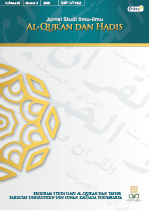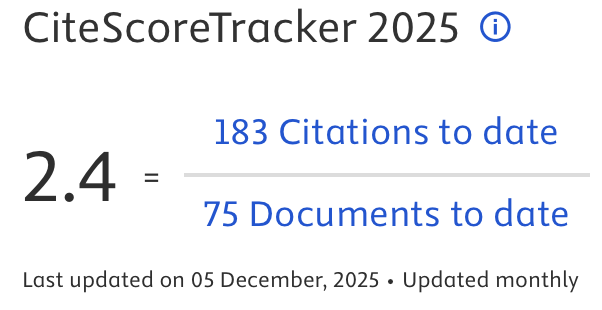Pious yet Trendy Young Muslim: ‘The Bros Team’ and Public Qur’an in Indonesia
DOI:
https://doi.org/10.14421/qh.v23i2.4465Keywords:
Muslim Youth, Quranic recitation, Public Qur’an, Social MediaAbstract
This article discusses the intersection of Quranic reciting practices and pop culture through the emergence of The bros team, which is popular among modern Indonesian young Muslims. Since the fall of the New Order dictatorship, the Quran's recitation has become more public, shaping the Islamic soundscape in Indonesia’s online-offline public spaces. As a group of Quran reciters representing pious Muslim youth in Indonesia, the Bros team's popularity among Indonesians youth demonstrates how young people manage their identity as part of global pop culture while being rooted to Islamic orthodoxy. This group uploads murattal content of Quranic recitations on social media such as YouTube and Instagram. Those contents highlights how they appear to recite the Quran by incorporating parts of pop culture trend that are familiar to young people. Pertaining to this facts, this research contends that mediated Quranic practice via social media platforms shapes particular implications and treatments of the Quran and performers. Through online and offline field research, this study investigates how the popularity of The Bros team articulates the religious development of young Muslims in relation to the practice of public Quran recitation as a form of negotiating identity for devout Muslim Youths in Indonesia.
 Abstract viewed: 396 times
|
Abstract viewed: 396 times
|
 PDF downloaded = 376 times
PDF downloaded = 376 times
References
Barendregt, Bart. “Pop, Politics and Piety: Nasyid Boy Band Music in Muslim Southeast Asia.” In Islam and Popular Culture in Indonesia and Malaysia, edited by Andrew N. Weintraub. New York: Routledge, 2011.
Campbell, Heidi. When Religion Meets New Media. New York: Routledge, 2010.
Campbell, Heidi A. “Introduction: The Rise of the Study of Digital Religion.” In Digital Religion: Understanding Religious Practice in New Media Worlds, edited by Heidi A. Campbell. London-New York: Routledge, 2013.
Dawson, Lorne L., and Douglas E. Cowan, eds. Religion Online: Finding Faith on the Internet. New York - London: Routledge, 2013.
Fealy, Greg, and Sally White. “Introduction.” In Expressing Islam: Religious Life and Politics in Indonesia, edited by Greg Fealy and Sally White. Singapore: Institute of Southeast Asian Studies, 2008.
Gade, Anna M. Perfection Makes Practice: Learning, Emotion, and the Recited Quran in Indonesia. Honolulu: University of Hawaii Press, 2004.
Hariyanti, Puji. “Generasi Muda Muslim Dan Gerakan Sosial Spiritual Berbasis Media Online.” Jurnal ILMU KOMUNIKASI 13, no. 2 (2016): 165–178.
Hasan, Noorhaidi. “Education, Young Islamists and Integrated Islamic Schools in Indonesia.” Studia Islamika 19, no. 1 (2012): 77–111.
———. The Making of Public Islam Piety, Democracy and Youth in Indonesian Politics. Yogyakarta: Sukapress, 2013.
Hefner, Robert W. Civil Islam: Muslims and Democratization in Indonesia. Princeton: Princeton University Press, 2001.
Heryanto, Ariel. Identity and Pleasure: The Politics of Indonesian Screen Culture. Singapore: NUS Press, 2014.
———, ed. Popular Culture in Indonesia: Fluid Identities in Post-Authoritarian Politics. London: Routledge, 2008.
Husein, Fatimah, and Martin Slama. “Online Piety and Its Discontent: Revisiting Islamic Anxieties on Indonesian Social Media.” Indonesia and the Malay World 46, no. 134 (January 2, 2018): 80–93.
Jones, Carla. “Fashion and Faith in Urban Indonesia.” Fashion Theory 11, no. 2–3 (June 1, 2007): 211–231.
———. “Materializing Piety: Gendered Anxieties about Faithful Consumption in Contemporary Urban Indonesia.” American Ethnologist 37, no. 4 (2010): 617–637.
Lim, Merlyna. “The Internet and Everyday Life in Indonesia: A New Moral Panic?” Bijdragen tot de taal-, land- en volkenkunde / Journal of the Humanities and Social Sciences of Southeast Asia 169, no. 1 (January 1, 2013): 133–147.
Lovheim, Mia. “Identity.” In Digital Religion: Understanding Religious Practice in New Media Worlds, edited by Heidi A. Campbell, 41–56. London-New York: Routledge, 2013.
Lukens-Bull, Ronald. “Commodification of Religion and the ‘Religification’ of Commodities: Youth Culture and Religious Identity.” In Religious Commodifications in Asia: Marketing Gods, edited by Pattana Kitiarsa, 220. London: Routledge, 2007.
Mukaromah, Kholila, and Ulfah Rahmawati. “THE INFLUENCE OF THE ONE DAY ONE JUZ (ODOJ) MOVEMENT ON THE TRADITION OF RECITING QUR’AN.” QIJIS (Qudus International Journal of Islamic Studies) 3, no. 2 (August 1, 2015): 148–167.
Muslim, Acep. “Digital Religion and Religious Life in Southeast Asia: The One Day One Juz (Odoj) Community in Indonesia.” Asiascape: Digital Asia 4, no. 1–2 (February 23, 2017): 33–51.
Nef-Saluz, Claudia. Islamic Pop Culture in Indonesia : An Anthropological Field Study on Veiling Practices among Students of Gadjah Mada University of Yogyakarta. Bern: Institute fur Sozialanthropologie, Universitat Bern, 2007. Accessed April 7, 2023. https://cir.nii.ac.jp/crid/1130000796431934720.
Nelson, Kristina. The Art of Reciting the Qur’an. Austin: University of Texas Press, 1986.
Nilan, Pam, and Carles Feixa, eds. Global Youth?: Hybrid Identities, Plural Worlds. London: Routledge, 2006.
Nisa, Eva F. “Creative and Lucrative Daʿwa: The Visual Culture of Instagram amongst Female Muslim Youth in Indonesia.” Asiascape: Digital Asia 5, no. 1–2 (February 14, 2018): 68–99.
———. “Social Media and the Birth of an Islamic Social Movement: ODOJ (One Day One Juz) in Contemporary Indonesia.” Indonesia and the Malay World 46, no. 134 (January 2, 2018): 24–43.
Porter, Donald J. Managing Politics and Islam in Indonesia. London: RoutledgeCurzon, 2002.
Ricklefs, Merle Calvin. Islamisation and Its Opponents in Java: A Political, Social, Cultural and Religious History, C. 1930 to Present. Singapore: NUS Press, 2012.
Rosyad, Rifki. A Quest for True Islam: A Study of the Islamic Resurgence Movement among the Youth in Bandung, Indonesia. Canberra: ANU Press, 2007.
Schmidt, Leonie. “Urban Islamic Spectacles: Transforming the Space of the Shopping Mall during Ramadan in Indonesia.” Inter-Asia Cultural Studies 13, no. 3 (September 1, 2012): 384–407.
Smith-Hefner, Nancy J. “Javanese Women and the Veil in Post-Soeharto Indonesia.” The Journal of Asian Studies 66, no. 2 (May 2007): 389–420.
Suaidi Asyari, and M. Husnul Abid. “Expanding the Indonesian Tarbiyah Movement through Ta‘āruf and Marriage.” Al-Jami’ah: Journal of Islamic Studies 54, no. 2 (December 14, 2016): 337–368.
Weintraub, Andrew N., ed. Islam and Popular Culture in Indonesia and Malaysia. New York: Routledge, 2011.
“ayah_amanah EO (@ayah_amanah) • Foto dan video Instagram.” Accessed April 8, 2023. https://www.instagram.com/ayah_amanah/.
“Ini Media Sosial Paling Populer Di Indonesia | Databoks.” Accessed April 8, 2023.
Downloads
Published
How to Cite
Issue
Section
License
Copyright (c) 2022 Imas Lu’ul Jannah

This work is licensed under a Creative Commons Attribution-NonCommercial-NoDerivatives 4.0 International License.
Publishing your paper with Jurnal Studi Ilmu-ilmu al-Qur'an dan Hadis means that the author or authors retain the copyright in the paper. Jurnal Studi Ilmu-ilmu al-Qur'an dan Hadis uses license CC-BY-NC-ND or an equivalent license as the optimal license for the publication, distribution, use, and reuse of scholarly works. This license permits anyone to copy and redistribute the material in any medium or format and must give appropriate credit, provide a link to the license, and indicate if changes were made. If you remix, translate, transform or build upon the material you may use it for private use only and not for distribution. Jurnal Studi Ilmu-ilmu al-Qur'an dan Hadis granted an exclusive non-commercial reuse license by the author(s), but the author(s) are able to put the paper onto a website, distribute it to colleagues, give it to students, use it in your thesis, etc, so long as the use is not directed at a commercial advantage or toward private monetary gain. The author(s) can reuse the figures and tables and other information contained in their paper published by Jurnal Studi Ilmu-ilmu al-Qur'an dan Hadis in future papers or work without having to ask anyone for permission, provided that the figures, tables, or other information that is included in the new paper or work properly references the published paper as the source of the figures, tables or other information, and the new paper or work is not direct at a private monetary gain or commercial advantage.
Jurnal Studi Ilmu-ilmu al-Qur'an dan Hadis journal Open Acces articles are distrubuted under the Creative Commons Attribution-NonCommercial-NoDerivatives 4.0 International (CC BY-NC-ND 4.0). Article can be read, copy and redistribute the material ini any medium or format under the following conditions:
Attribution — You must give appropriate credit, provide a link to the license, and indicate if changes were made. You may do so in any reasonable manner, but not in any way that suggests the licensor endorses you or your use.
NonCommercial — You may not use the material for commercial purposes.
NoDerivatives — If you remix, transform, or build upon the material, you may not distribute the modified material.










